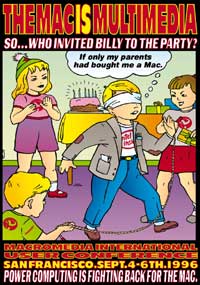![]()
Service and Support
Shortly after graduating from the University of Texas in 1996, Power Computing hired me for a customer service position in their growing call center. Power Computing was the first and largest Macintosh clone company and a darling of the Austin and Mac business press.
In its early days, the high-energy environment at Power Computing was slightly better than controlled chaos. I proved to function well in an environment with heavy customer demands and little hands-on direction from senior management.
New Hire Training
I quickly filled a unique liaison position between Service and Finance. This position parlayed into a full-time training role where I developed, improved and taught curriculum for all Customer Service new-hires. This position and rapid company growth made it clear we needed a definition of standard operating business procedures. I developed a template for the standards in a FileMaker Pro database and authored many of the original articles. The system was expanded to accommodate all major departments and was used daily by hundreds of employees.
Intranet / Extranet Development
Power’s IT managers were busy building and maintaining an infrastructure for such a fast-growing company, so they were not able to support stand-alone applications. Fortunately, Power’s management had the foresight to invest in private web-based communications. They tapped me to join a core production team to work with department managers, trainers, steering committees and content owners to build a company-wide Intranet to serve all employees. We were tasked with identifying the needs of Power’s employees and management, then developing intuitive business tools that enabled them to execute their duties and speed information flow.
We collaborated with Power’s HR, IT, R&D Engineering, Service & Support and Sales teams and oversaw the entire design and launch of the Intranet. We built specialized web tools ranging from rebate coupon trackers to random tech support tests. As Power grew and partnered with outsource providers, we transitioned to an Extranet model to encompass teams in Round Rock, Buffalo, St. Paul, Las Vegas and Cupertino. The final product met Power’s need for a powerful yet functional resource for an audience ranging from field support agents to the Executive Team.
This project played host to several database-to-web integrations complete with web-enabled administration, automated updates and HTML generators. We primarily using FileMaker Pro and Tango. This was in 1996-1997 when our only support came from email LISTSERVs, so these applications were innovative at the time.
By embracing web technologies and producing one of the first e-commerce sites in the PC industry, Power Computing held a strategic edge over the competition. A few of the tools I helped to create include:
* A news database that displays department specific articles;
* A product comparison sales tool that dynamically compared Power’s and competitor’s products;
* An online test for technical field reps and tech support new hires;
* A rebate coupon management tool;
* Online Technical Support and Customer Service policies, procedures, and protocols;
* Real-time order status, depot repair status and customer account/credit status.
The successes I had with Power’s Extranet and my exposure to key people in every critical role of the company led to my position on a Case Management vendor selection committee. This role gave me insight into enterprise level software systems like SAP and Clarity. I learned how to identify business needs, perform gap analysis of multiple systems and articulate my recommendations. I also served on the testing and quality assurance team during the rollout of Power’s Oracle ERP system.
Power Computing eventually closed its doors when Steve Jobs returned to Apple in 1997 and promptly bought back the licensing rights for $100,000,000. I turned down offers with local high-tech companies, opting instead to apply my skills and contacts in the founding of Stream Studio Web Architects. Read more about this history at Stream Studio.
